
The Basilica of Santa Croce, translated from Italian: the Church of the Holy Cross (Basilica di Santa Croce) is one of the oldest religious buildings in Florence and one of the largest Franciscan churches in the world, famous for its works of art and burials.
Santa Croce is a monumental complex, which is one of the most popular attractions in Florence.
The complex includes the church itself with chapels, frescoes by famous artists, including Giotto, and numerous tombs of great people of Italy, including Michelangelo and Galileo, as well as monasteries with a museum, a sacristy, a crypt, chapels of Pazzi and Medici.
Thanks to the abundance of tombs, the basilica is called the "Florentine Pantheon", and thanks to the halls of fame and memory - the "Temple of Italian Glory" (Tempio dell'itale Glorie).

Panoramic view of the Holy Cross complex and the adjacent ensemble from the observation deck of the dome of the Cathedral of Florence
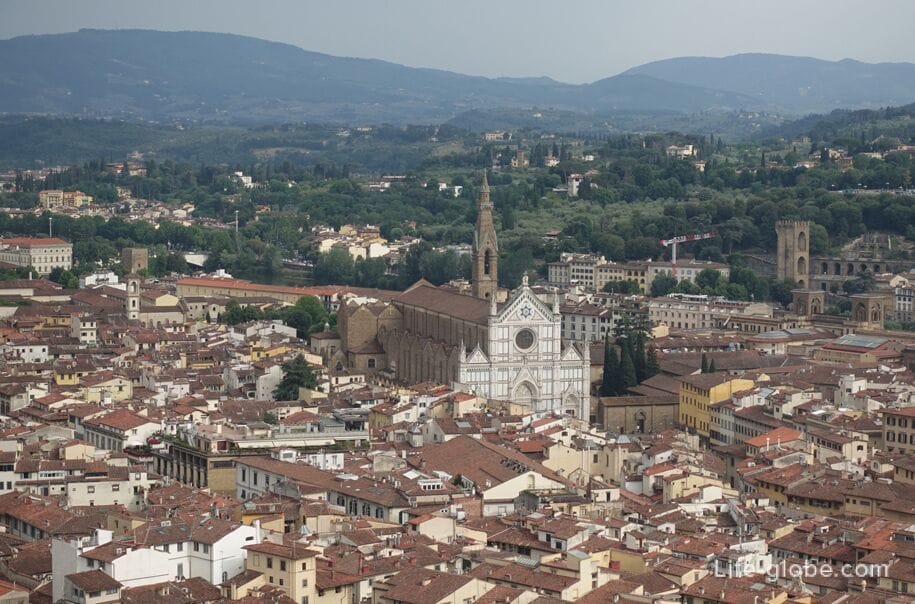
Legend has it that Santa Croce was founded by Saint Francis of Assisi.
The construction of the current church on the site previously occupied by another building was started on May 3, 1294, possibly designed by the architect Arnolfo di Cambio. However, the memorial plaque, immured in the right aisle of the basilica, refers the laying of the church to 1295, and this date is considered the most reliable today. The consecration of the shrine took place in 1442 by Pope Eugene IV.
During its history, the complex has undergone various transformations, modifications and restorations. The most important transformation is the Vasari changes in the sixteenth century.
The exterior facade of the church is made of stone, it is a dynamic sequence of pointed tympanums running along the sides and apse, with inserts of cruciform decorative elements. The current church bell tower, designed by Gaetano Baccani dates back to 1847, and the facade, which remained unfinished until the middle of the nineteenth century, was completed by architect Niccolo Matas in the Neo-Gothic style in 1865.
The main Neo-Gothic marble facade, facing the eponymous Piazza Santa Croce (Piazza di Santa Croce), stands out with a large rose window and an outstanding star of David.
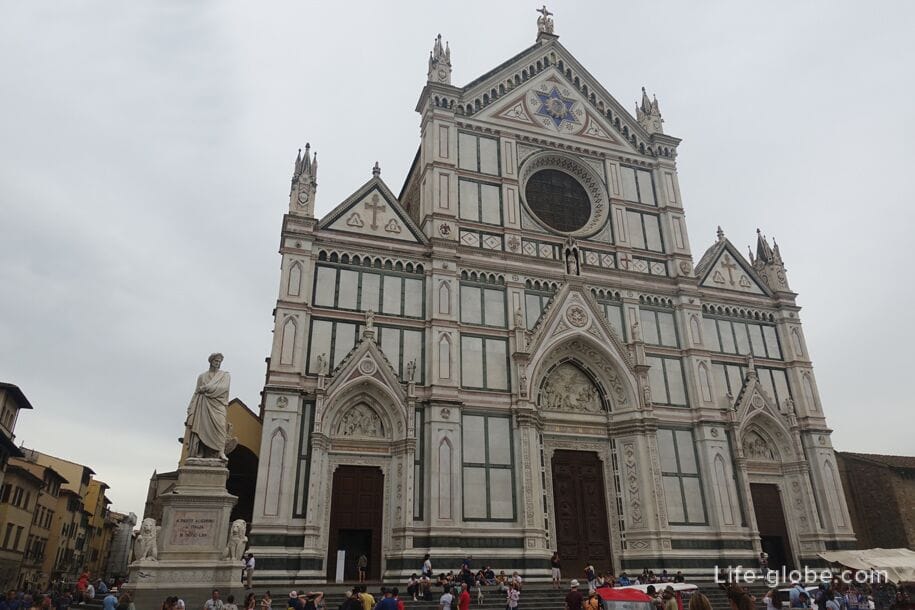
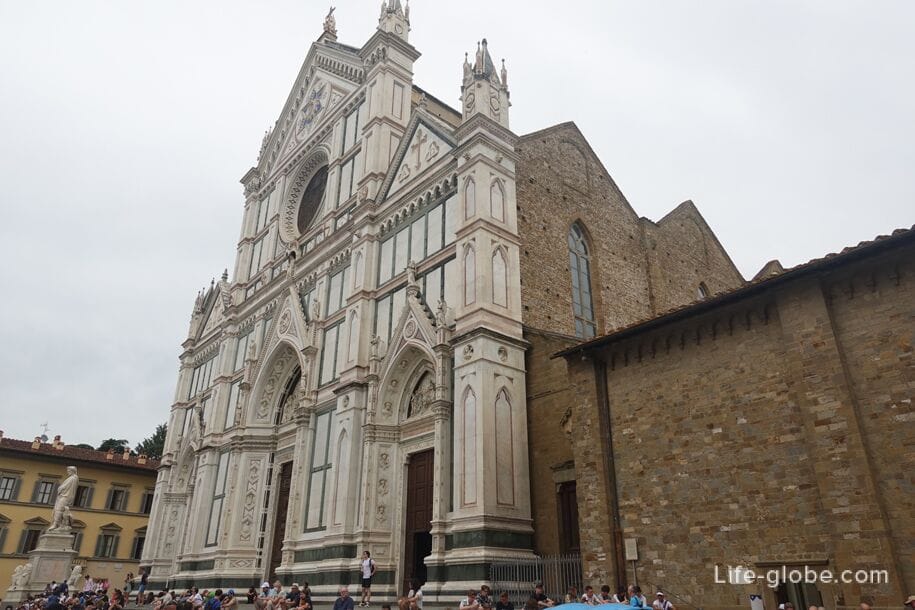
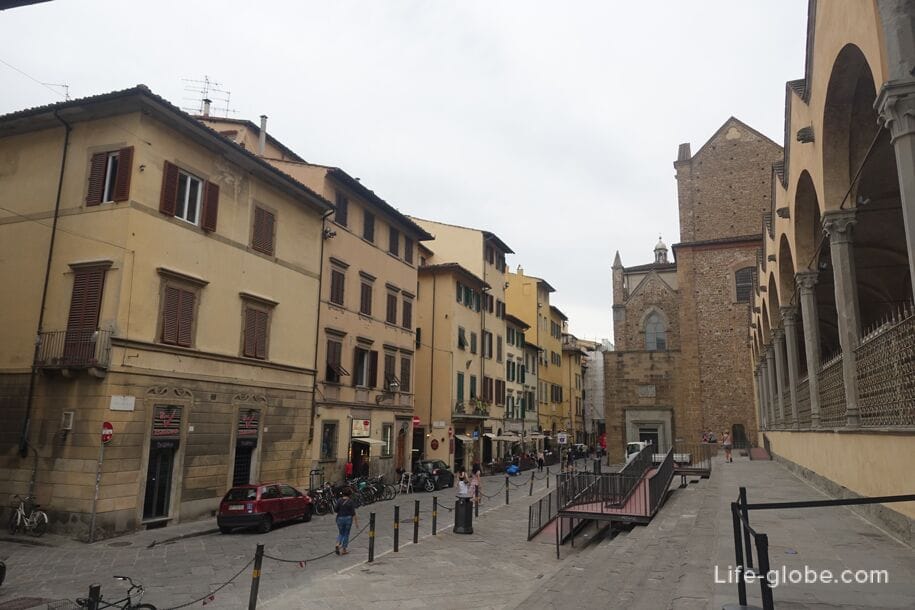
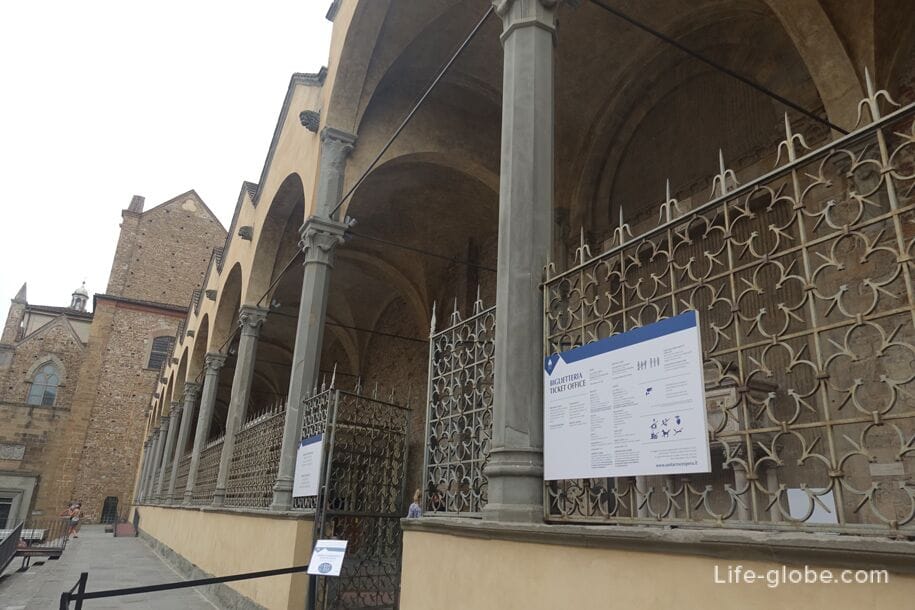
Near the main entrance to the basilica there is a monumental marble monument to Dante Alighieri with a raven (Monumento a Dante Alighieri).
The monument was created in 1865 in honor of the 600th anniversary of Dante's birth, and is the work of Italian sculptor Enrico Pazzi.

The church has three naves separated by octagonal columns with pointed arches.
The central nave has a height of 34 meters and a width of 20 meters, and visually merges with the side aisles, creating a sense of a single volumetric space, as in the early Christian basilicas of Rome.
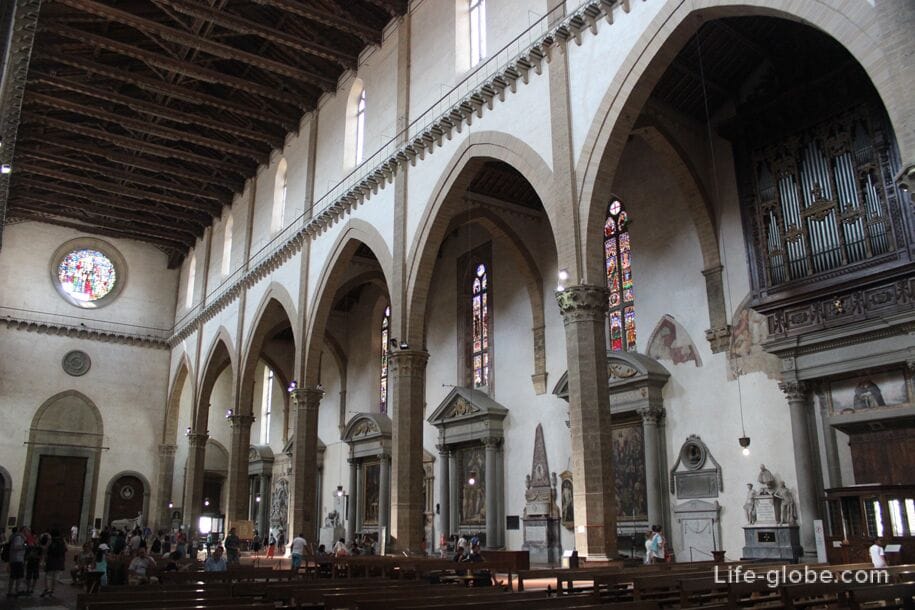
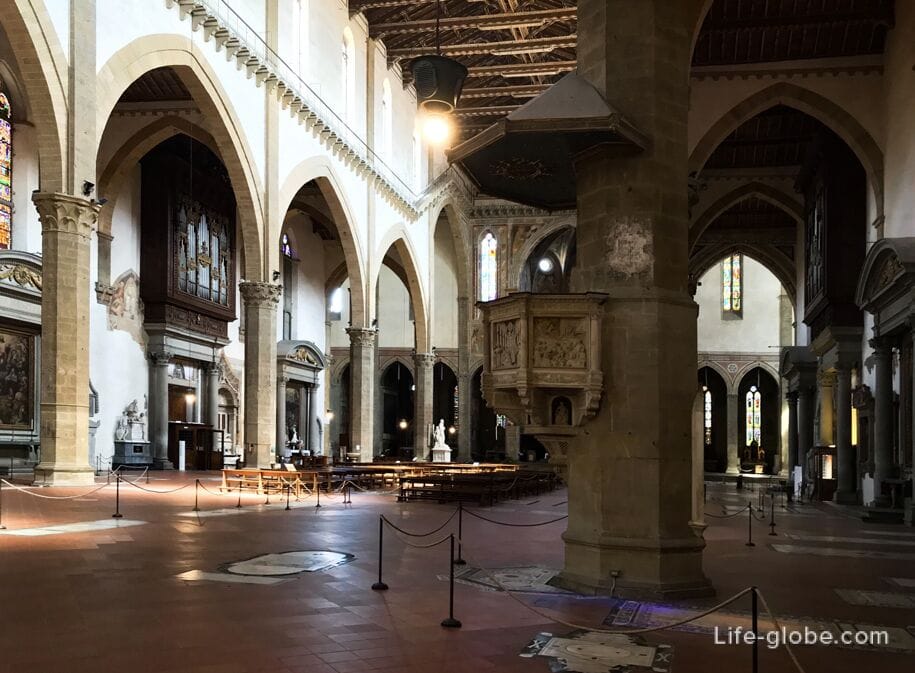
Inside Santa Croce there are almost 4,000 picturesque masterpieces from the thirteenth to the twentieth century. These are frescoes created by great masters of their time, including Giotto di Bondone, Maso di Banco, Bernardo Daddi, Taddeo Gaddi, Agnolo Gaddi, Giovanni da Milano, Matteo di Pacino, Jacopo del Casentino, Domenico Veneziano and Sebastiano Mainardi.
The main altar is surrounded by frescoes "The Legend of the True Cross" by Agnolo Gaddi. A large Crucifix (cross) occupies a central place in the altar, as a symbol of the crucifixion of Christ, the sacrifice that brought salvation to mankind.

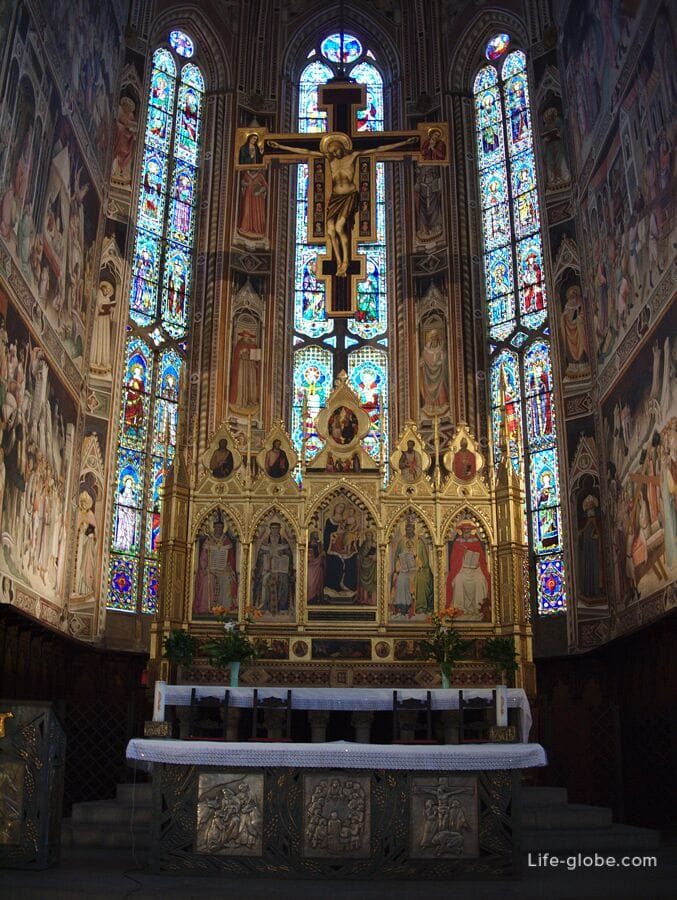
The Church of the Holy Cross has the form of a Latin cross with a transept, on which there are chapels facing east, five on each side of the main chapel; chapels are added to them, which open in the arms of the transept.
The chapels are decorated with frescoes, stained glass windows, sculptures, altars, and in some there are monumental tombs.
From the chapels:
- Chapel of Salviatti (Cappella Salviati);
- Chapel of Bardi di Vernio (Cappella Bardi di Vernio);
- Nicolini Chapel (Cappella Niccolini);
- Bardi Chapel in Mangona (Cappella Bardi di Mangona);
- Large Chapel (Cappella Maggiore) - main chapel;
- The Bardi Chapel (Cappella Bardi) dedicated to Saint Francis;
- Chapel of Peruzzi (Cappella Peruzzi), the painting cycle of which is one of the first evidences of Giotto in Santa Croce and is the only known example of a wall painting made by the artist almost completely dry;
- Chapel of Giugni Bonaparte (Cappella Giugni Bonaparte);
- Chapel of the Baroncelli (Cappella Baroncelli), dedicated to the Virgin of the Annunciation;
- Chapel of the Castellani (Cappella Castellani).
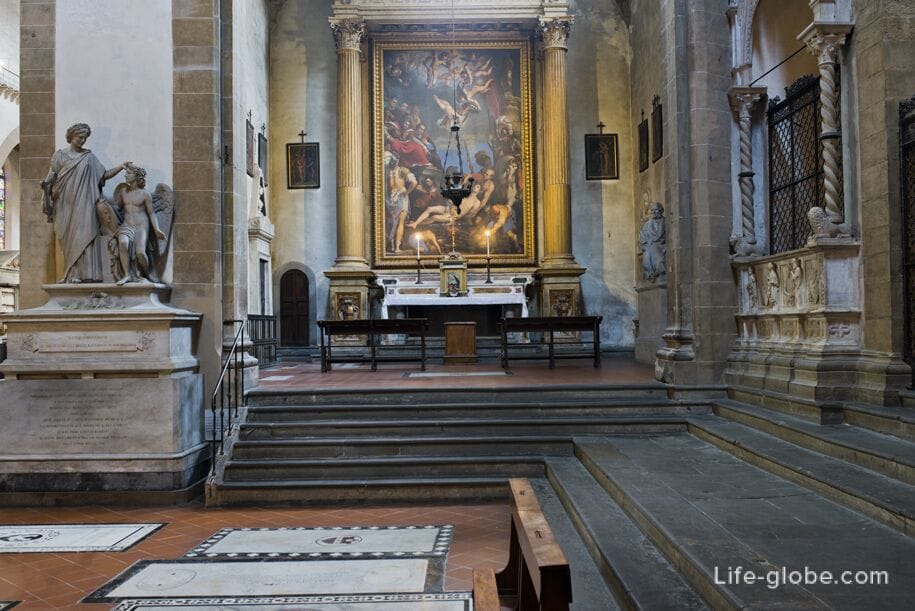
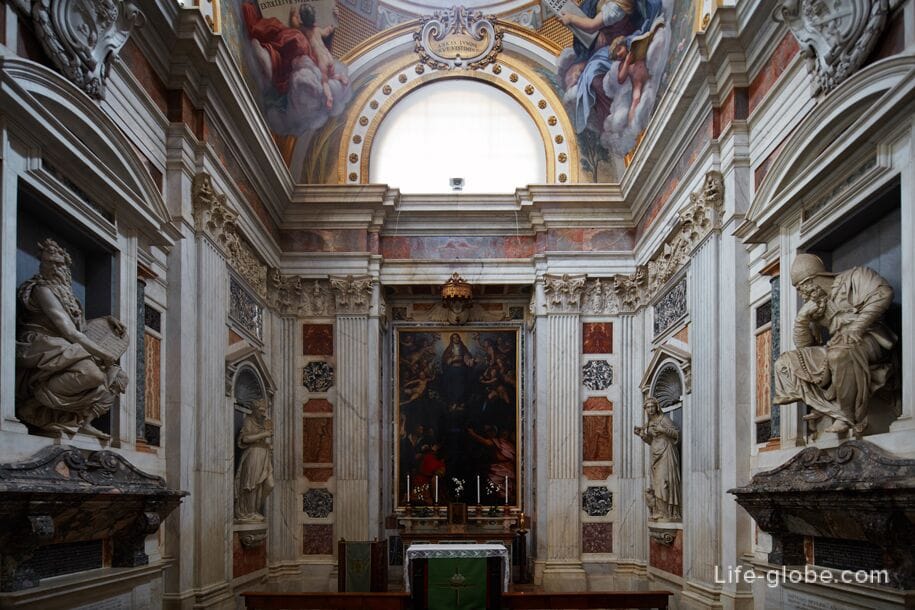
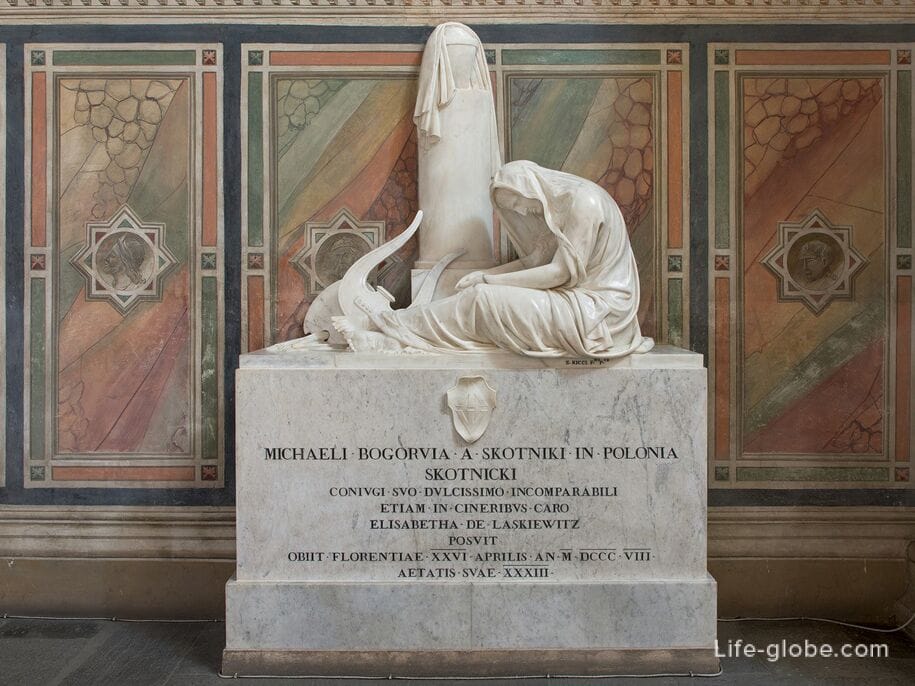
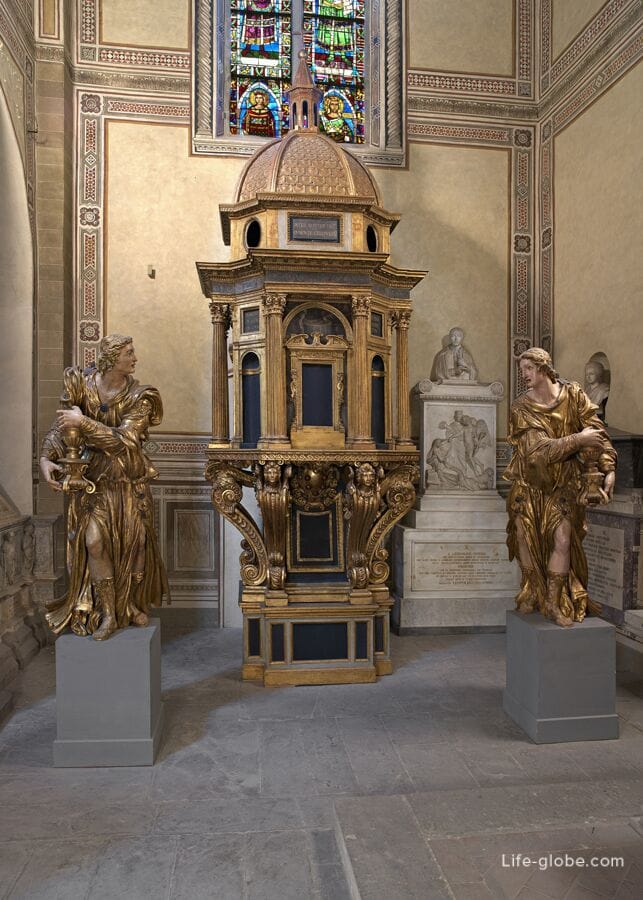
The sacred spaces of churches and monasteries have for centuries welcomed the bodies of the dead and their burials, designed to pass on memory to posterity: a call to memory that has always distinguished Santa Croce.
There are floor tombs and monumental tombs in the church. There are about 300 graves in the complex.
Originally, the church had floor tombs intended for Franciscans who played a certain role in the Order, for members of the most powerful families and for great leaders.

Thus, Biordo degli Ubertini (died in 1348) stands out with a memorial plaque depicting the deceased in armor, framed by a tabernacle in the Gothic style.

The first example of the Renaissance is the tombstone of Bartolomeo Valori (died 1427) by the Italian sculptor Lorenzo Ghiberti. It was a model for many other tombstones, in which the image becomes more realistic with the removal of the tabernacle and taking into account land use. The use of this type of burial has persisted for centuries, as evidenced by the tombstone of Emilia Toscanelli Peruzzi (who died in 1910) with a touch of Art Nouveau.

Monumental tombs have appeared since the 14th century. They consisted of an ark and sculptural elements.
In the fifteenth century, Leonardo Bruni and Carlo Marsuppini, two great writers who distinguished themselves as chancellors of the Florentine Republic, were buried in the church.
In 1564, Cosimo de' Medici gave a new impetus to the custom of honoring the memory of great illustrious people in the church by ordering the tomb of Michelangelo. Thus began the cultural policy of the Grand Duchy of Tuscany, which celebrates the talents that made Florence great, through the tombstones in Santa Croce. Among the tombs and memories of prominent personalities is the tomb of Galileo Galilei, who died in 1642. The construction of his tombstone was completed only in 1737. The same can be said about Niccolo Machiavelli, who died in 1527, whose monumental tomb was created only in 1787.
Photo of Michelangelo's monumental tomb
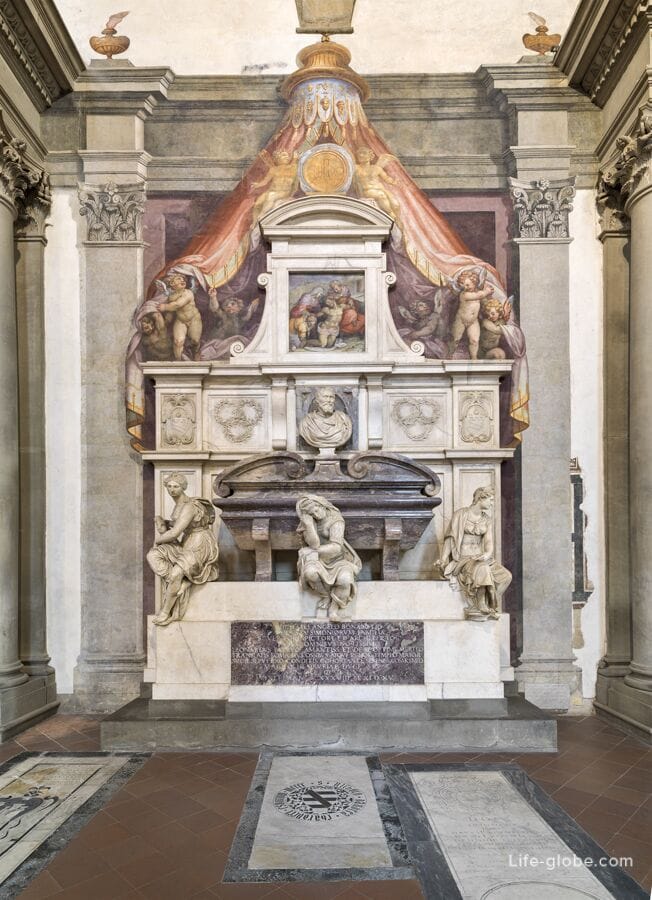
Photo of the monumental tomb of Galileo
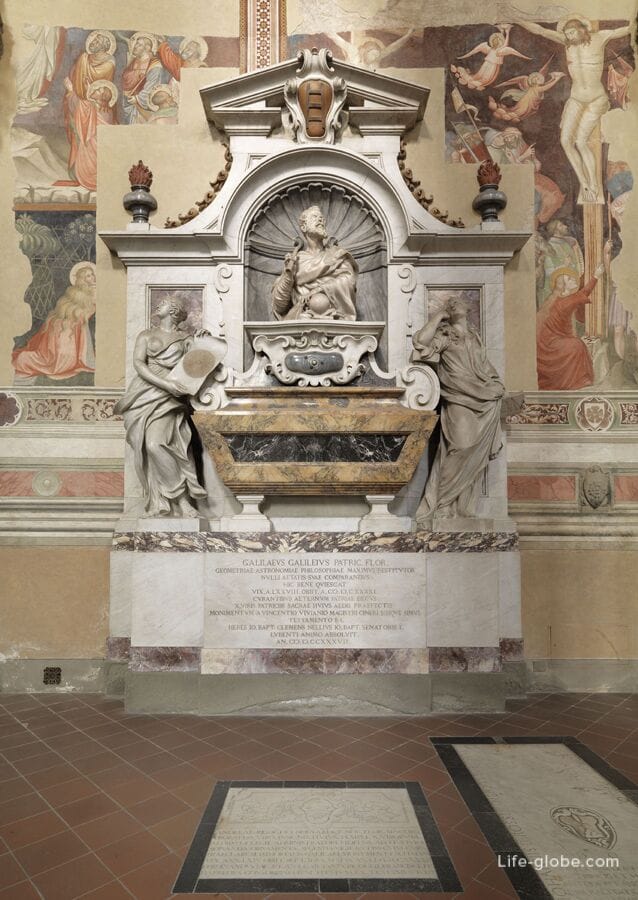
Photo of Machiavelli's monumental tomb
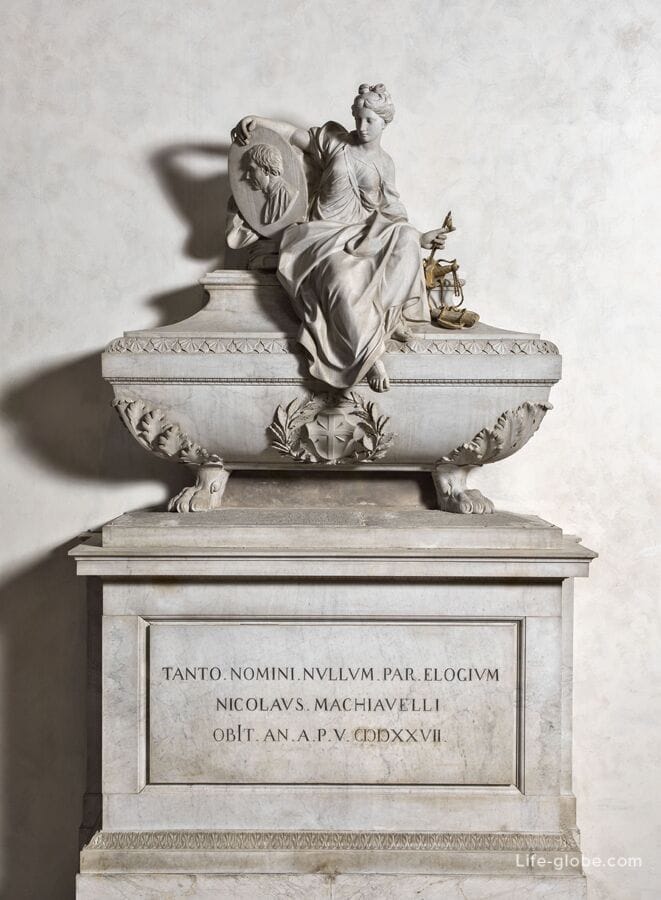
One of the most famous is the imposing cenotaph (or monumental tomb without a body), created in 1830 in memory of the father of the Italian language - the Florentine poet Dante Alighieri, who died five hundred years earlier in Ravenna and was buried there.
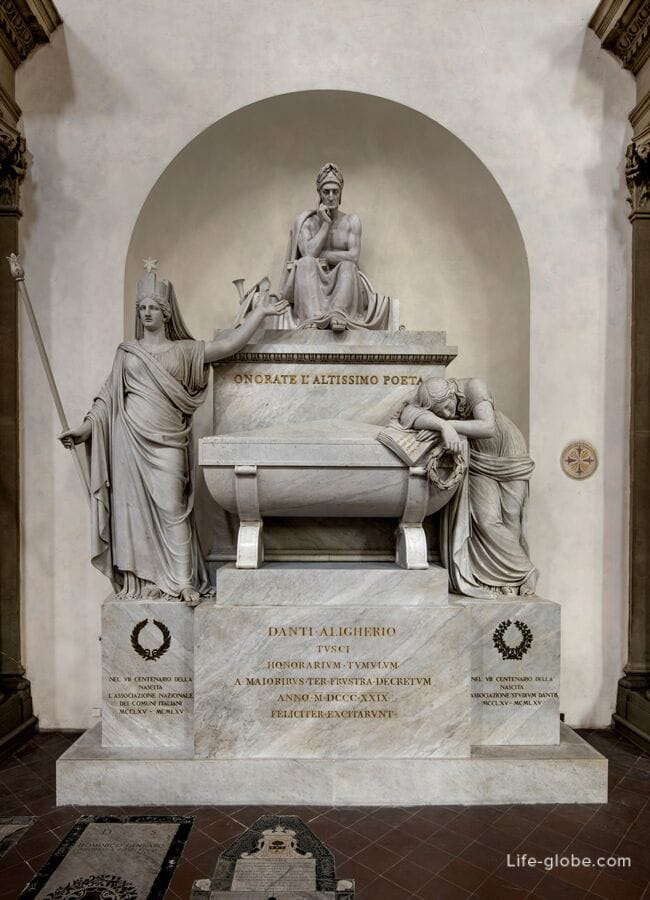
From the right transept of the basilica you can go to the sacristy and novitiate.
The latter was a place reserved for those who were preparing to join the Order.
It was built as part of a large-scale reconstruction and expansion project of the monastery undertaken after a fire in 1423 destroyed the old monks' dormitory. The intervention, probably designed by Michelozzo and carried out between 1435 and 1445, was fully funded by Cosimo de' Medici, whose coat of arms is still visible in this place.
This part of the complex includes:
- the sacristy is a room where objects related to worship are stored and where believers prepare for the celebration.
The sacristy is frescoed; it has a large crucifix of 1288 and antique furniture consisting of a central rack and side cabinets made between the fifteenth and sixteenth centuries (with subsequent changes). Today, as then, the vestments worn by monks before the liturgy have been preserved in these pieces of furniture;
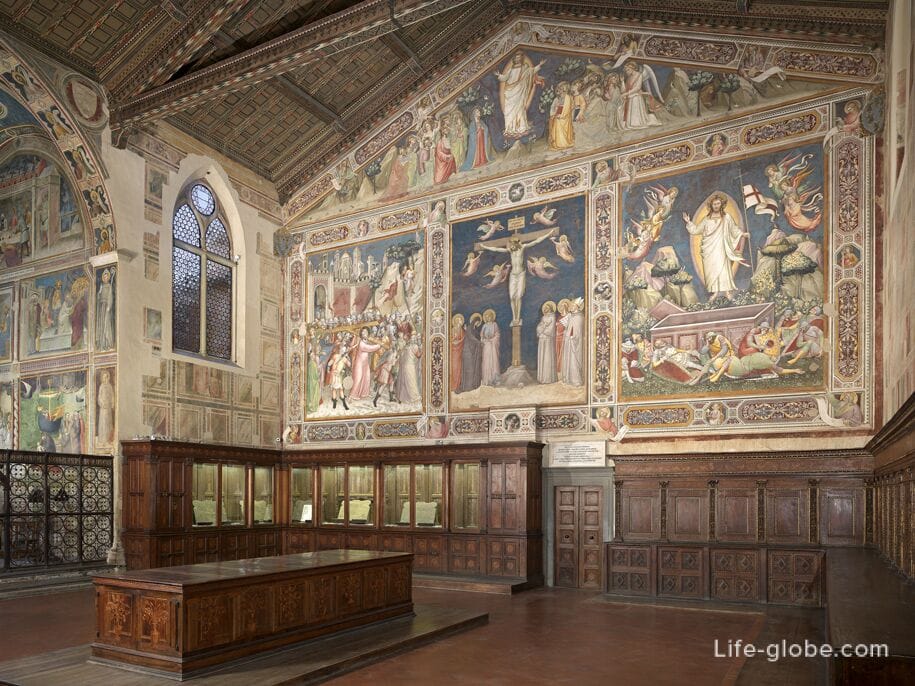

- the Chapel of Rinuccini, open on the east side of the sacristy, which has a square plan, covered with a cross vault, and is illuminated by two mullioned windows, open on the back wall and crowned with the coat of arms of Guidalotti.
The chapel is decorated with frescoes and has an altar with a polyptych by Giovanni del Biondo, dated 1379;

- Corridor of novices (Corridoio del Noviziato), the name of which comes from the original function of the connection between the church, the Medici chapel and the dormitory for novices. Access to the corridor is through a fifteenth-century door on the south side of the transept, and also allows entry into the sacristy and the Pozzo Hall. A staircase inside the monastery connects this area with rooms overlooking the monastery.
The construction of the corridor, which took place between 1435 and 1445, was financed by Cosimo de' Medici, who probably entrusted the project to Michelozzo, as evidenced by the characteristic architectural elements of the decorative language of the artist, and numerous coats of arms indicate the patronage of the Medici.
The room is paved with white marble tombstones and covered with a cylindrical vault; natural light comes from three three-million windows open on the western wall, and on the opposite side there is a monument to Lorenzo Bartolini by a pupil of Pasquale Romanelli (1858). There are masterpieces on display in the corridor, including The Coronation of the Virgin (early 15th century), attributed to Lorenzo di Niccolo, and The Trinity between Saints Benedict, Francesco, Bartolomeo and Giovanni Battista (1461) by Neri di Bicci;
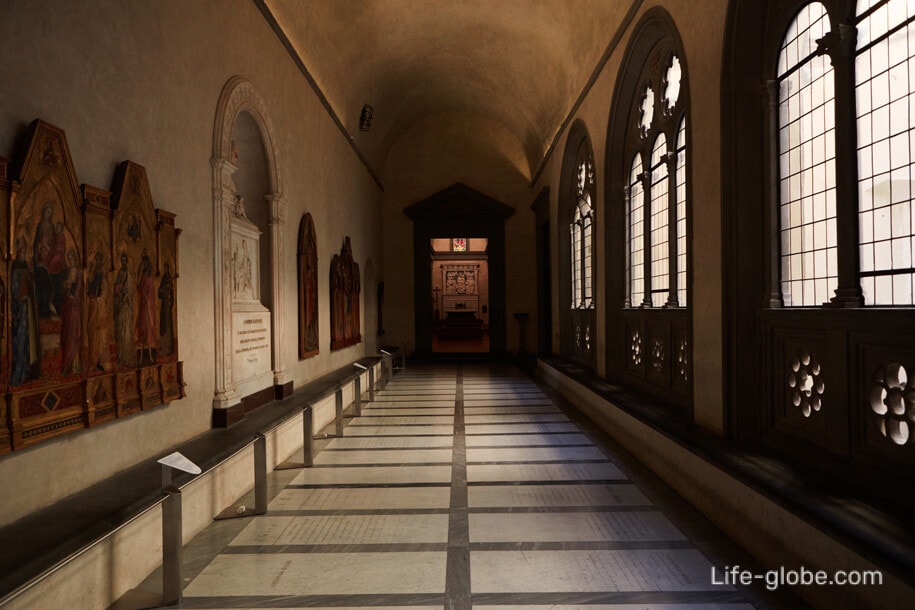
- The well room (Sala del Pozzo), which dates back to the fifteenth-century interventions commissioned by Cosimo de' Medici. Its function was strictly related to the function of the neighboring sacristy, and for this reason the room was equipped with cabinets for sacred vestments, a sink (cleaned in the twentieth century) and a well.
In the room, a niche with frescoes from about 1445, attributed to the painter Paolo Schiavo, which depicts Christ and the Samaritan woman at the well, catches the eye. In the niche there is a stone Medici coat of arms attributed to Michelozzo's workshop.
There are also paintings in the room, of particular interest among which is the Madonna with Child and Saints, painted by Nardo di Chione in 1365;
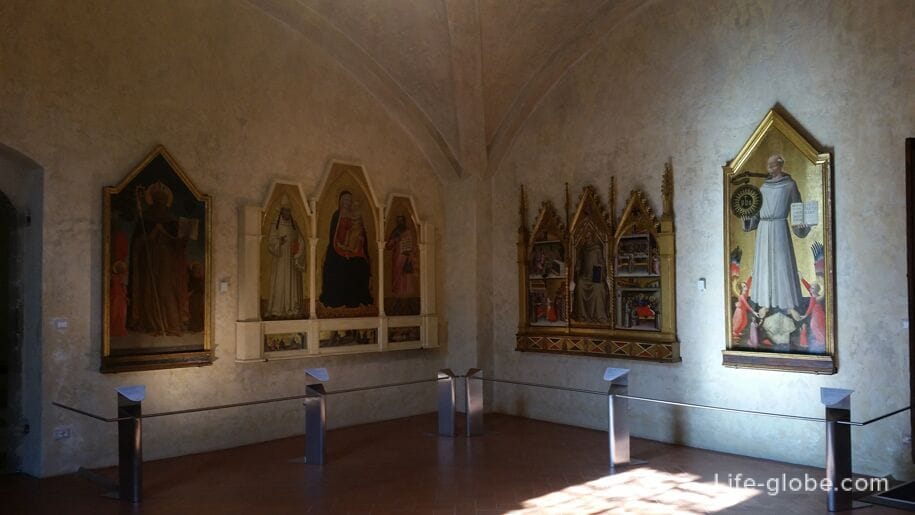
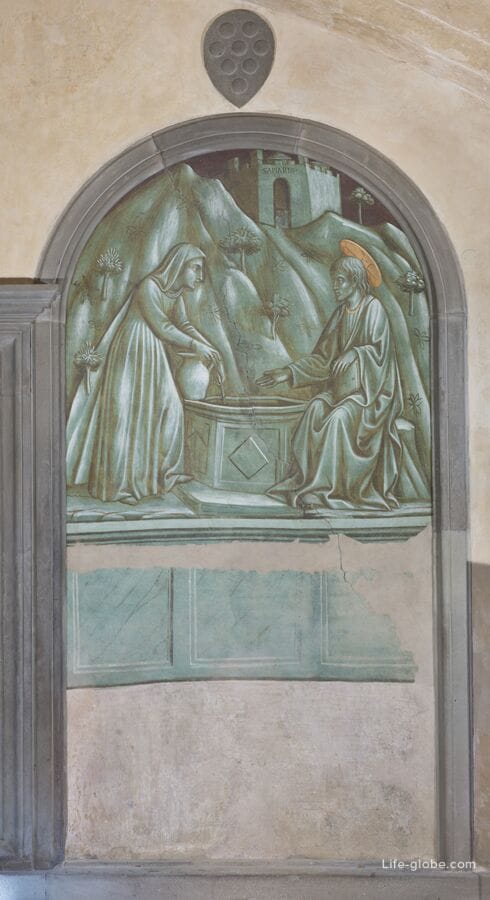
- The Medici Chapel (Cappella Medici), built between 1435 and 1445 thanks to the patronage of Cosimo de' Medici. The current structure of the chapel is the result of the intervention of 2014.
The connection with the Medici family is obvious from the time when it was named after the patron saints Cosmas and Damiano, depicted in a stained glass window around 1450, attributed to the Italian artist Alesso Baldovinetti. The saints were also present in the altar with the Madonna enthroned by Filippo Lippi (now in the Uffizi Gallery), replaced in 1810 by the Virgin in Majesty, glazed with terracotta from about 1495 by Andrea and Giovanni della Robbia.
In the compartment to the left of Scarsella, Galileo Galilei was buried after his death (1642), whose remains were transferred to a monumental tomb in the church only in 1737.
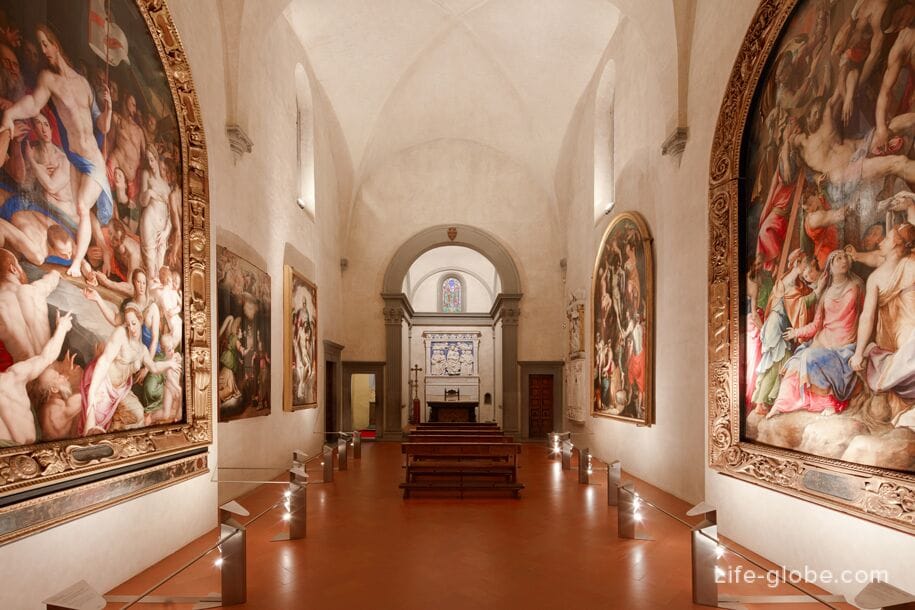
The spaces under the transept and the sacristy, the first to be built in Santa Croce, have always been used as a burial place and residence of religious fraternities.
Since 1934, it was decided to use part of the premises to create a "Memorial to the fallen for the Fascist Revolution." In 1934, Lenci also planned the reconstruction of the space under the sacristy, which commemorates the Florentines who fell in the First World War.
Between 1950 and 1956, the tomb was transformed and dedicated to the Florentines who died for their homeland after 1918, while the famedio dedicated to the war dead, whose memory is not controversial, was not changed and also retained its original structure and furniture.
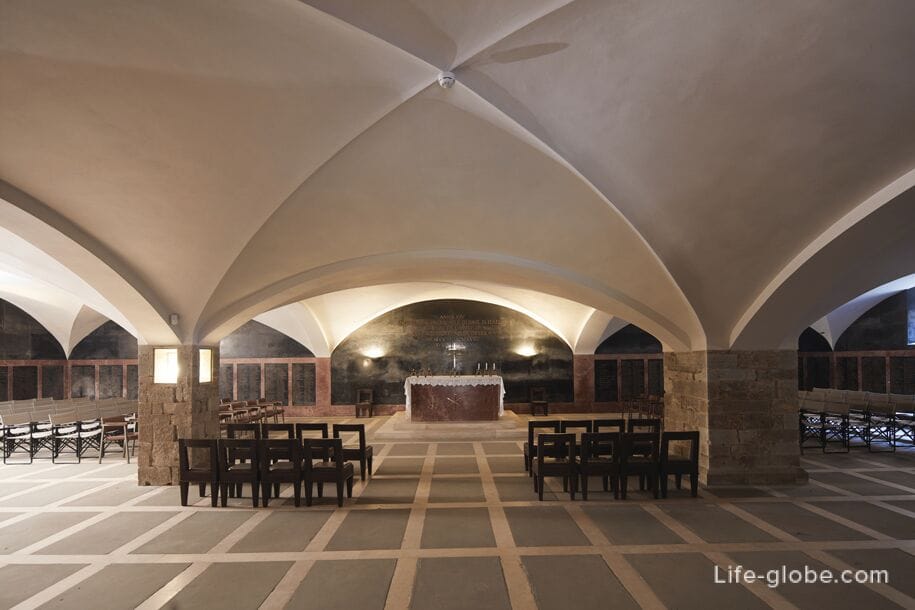
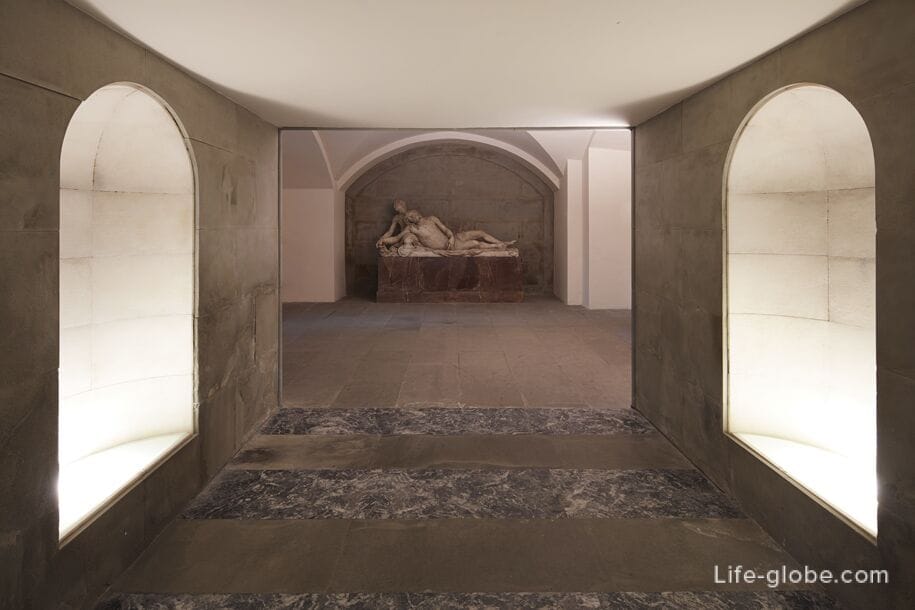
The monasteries of Santa Croce also had, among their functions, the function of connecting various parts of the complex, both those that were used exclusively by monastics, and others that also admitted laypeople who were in fraternities or had family burials.
In the courtyard of the first monastery, which was originally built in the early stages of the construction of the complex, there are sculptures.
The portal that separates the first from the second monastery, usually attributed to Benedetto da Maiano, was also assigned to Bartolomeo, Geri, Francesco and Desiderio da Settignano. The monastery, also known as the "Brunelleschi Monastery", although built many years after his death, was probably designed by Bernardo Rossellino for the very wealthy banker and generous philanthropist Tommaso Spinelli. The round arches of the upper loggia, now used by the National Central Library, are superimposed on the lower portico on stone columns.
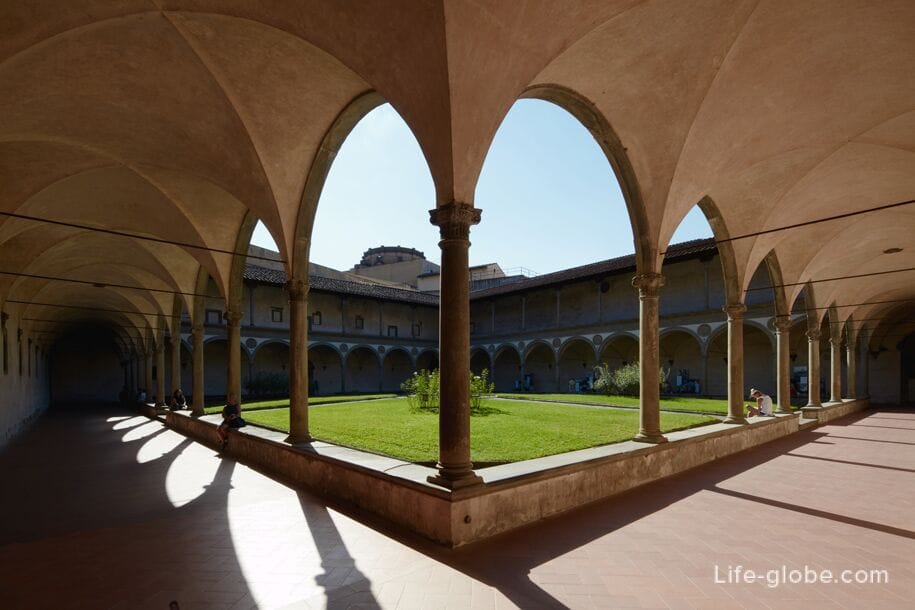
In the courtyard of the first monastery is the famous Pazzi Chapel (Cappella Pazzi) - one of the earliest and representative architecture of the Renaissance.
The chapel was commissioned by Andrea de Pazzi, a representative of one of the most influential Florentine families, as a noble chapel and chapter of the Franciscans. Filippo Brunelleschi probably designed the project between the late 1920s and the next decade and supervised the work from the very beginning in 1443 until his death in 1446. The construction stages lasted a long time and were interrupted in 1478, when the Pazzi were expelled after a conspiracy they hatched against the Medici.
The chapel is crowned with a dome. In the space of the exterior and interior, Brunelleschi created the image of an "ideal temple" - incredible lightness, at the same time combined with elegance and monumentality. Inside, the chapel is light and light; it stands out with order elements made of gray limestone "pietra serena" (pietra serena), bright accents of colored majolica by the Florentine workshop of Luca della Robbia and stained glass windows of the altar part.
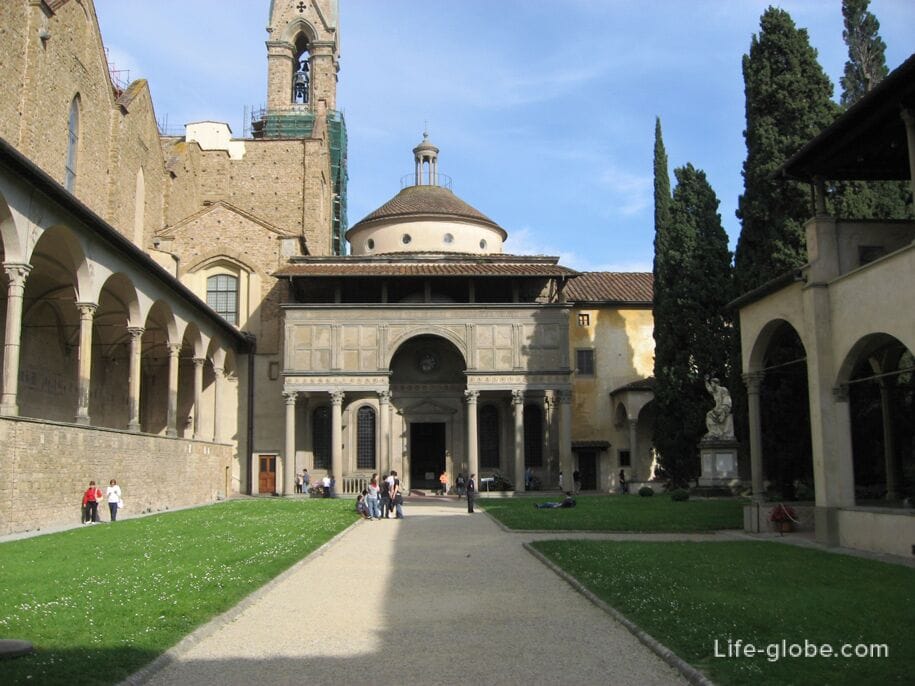
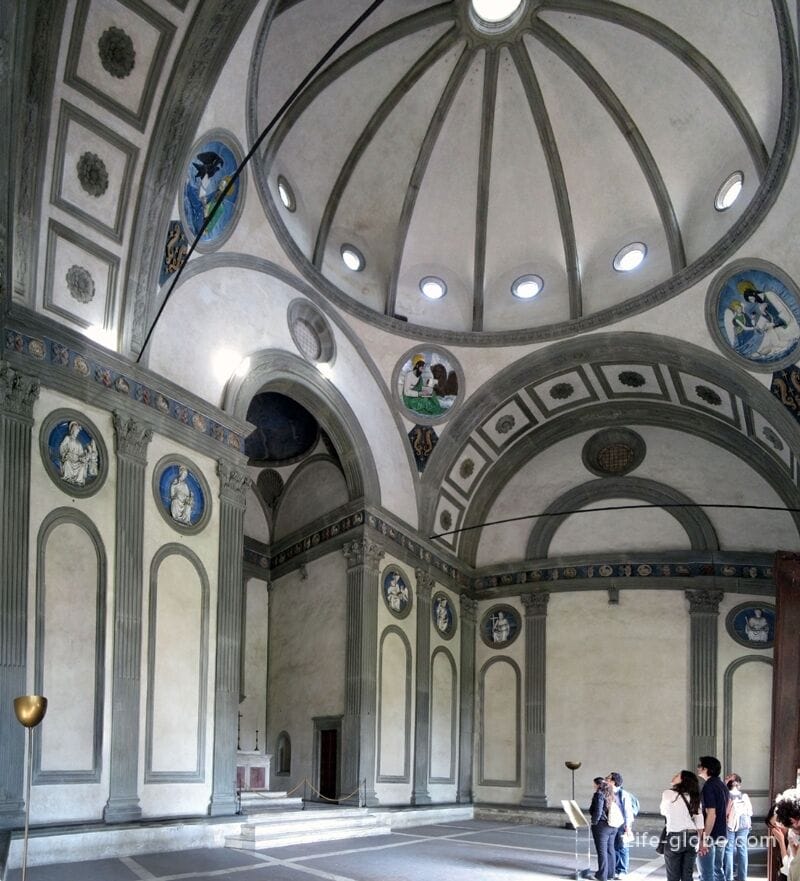
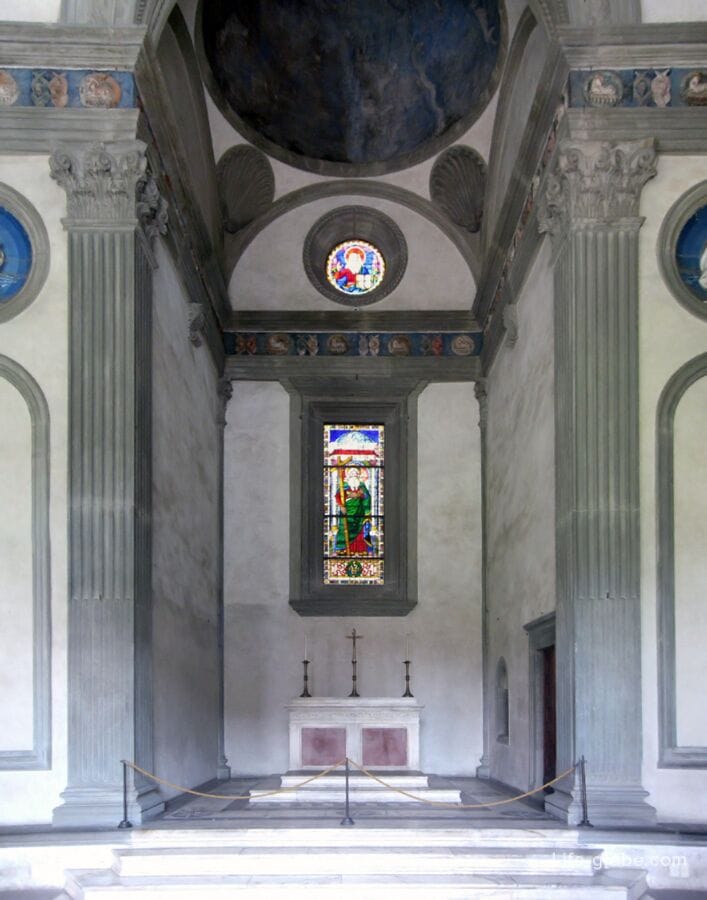
The Opera di Santa Croce Museum occupies the space of the ancient refectory (Cenacle) and the wing of the Franciscan monastery separating the two monasteries.
The Last Supper, a large rectangular room with a vaulted ceiling, illuminated by large windows with pillars, was designed and built in the early fourteenth century along with a gallery and loggia along the south side of the church, in one of the first buildings of the complex phase.
In the museum you can see other valuable paintings.
The ancient function of the room as a place for communication and reflection continues today thanks to conferences and concerts organized by the Santa Croce Opera Museum.

Services are held in the Church of Santa Croce.
Entrance to the church complex is paid, by tickets (there are discounted tickets).
Tickets can be purchased at the ticket offices of the complex or online in advance on the website.
Information about the complex, possible open places for visits, as well as opening hours and ticket prices, we recommend checking on the official website of the Basilica of Santa Croce complex: santacroceopera.it .
The Basilica of Santa Croce is located in the historical center of Florence, at address Piazza di Santa Croce, 16, 50122 Firenze FI, Italy.
Coordinates of the Basilica of Santa Croce: 43°46'06.0"N 11°15'44.0"E (43.768333, 11.262222).
All accommodation facilities in Florence (hotels, apartments, guest houses, etc.), including in the historical center of the city and more remotely from it, can be viewed and booked here